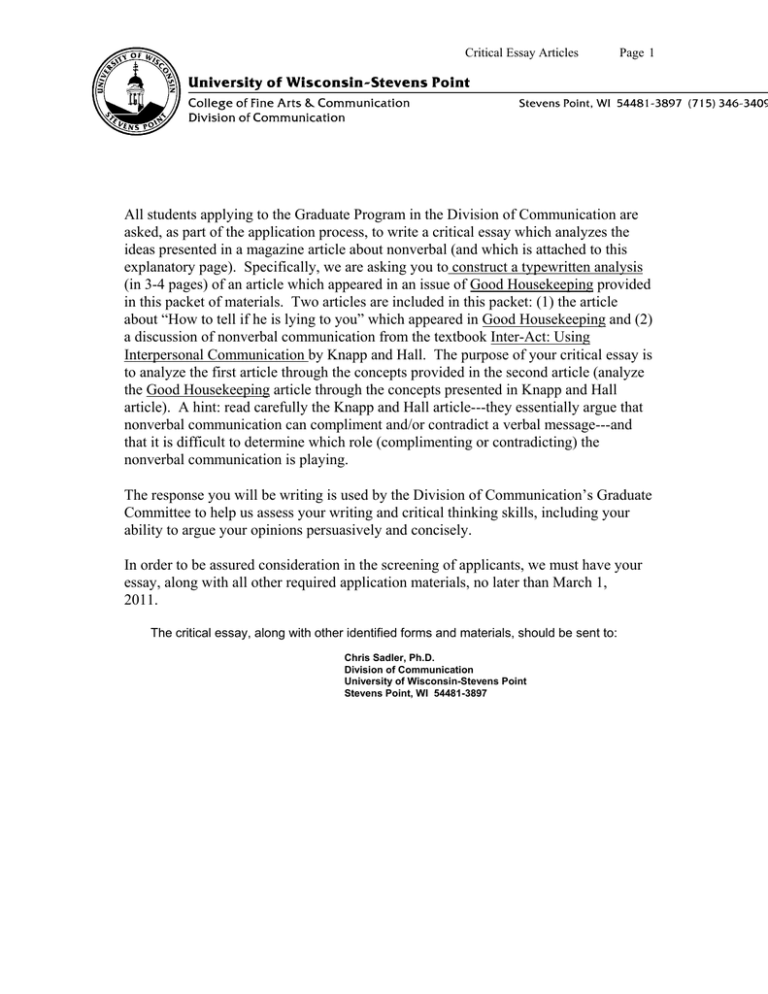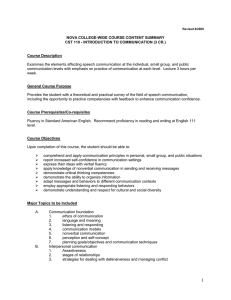All students applying to the Graduate Program in the Division... asked, as part of the application process, to write a...
advertisement

Critical Essay Articles
Page 1
All students applying to the Graduate Program in the Division of Communication are
asked, as part of the application process, to write a critical essay which analyzes the
ideas presented in a magazine article about nonverbal (and which is attached to this
explanatory page). Specifically, we are asking you to construct a typewritten analysis
(in 3-4 pages) of an article which appeared in an issue of Good Housekeeping provided
in this packet of materials. Two articles are included in this packet: (1) the article
about “How to tell if he is lying to you” which appeared in Good Housekeeping and (2)
a discussion of nonverbal communication from the textbook Inter-Act: Using
Interpersonal Communication by Knapp and Hall. The purpose of your critical essay is
to analyze the first article through the concepts provided in the second article (analyze
the Good Housekeeping article through the concepts presented in Knapp and Hall
article). A hint: read carefully the Knapp and Hall article---they essentially argue that
nonverbal communication can compliment and/or contradict a verbal message---and
that it is difficult to determine which role (complimenting or contradicting) the
nonverbal communication is playing.
The response you will be writing is used by the Division of Communication’s Graduate
Committee to help us assess your writing and critical thinking skills, including your
ability to argue your opinions persuasively and concisely.
In order to be assured consideration in the screening of applicants, we must have your
essay, along with all other required application materials, no later than March 1,
2011.
The critical essay, along with other identified forms and materials, should be sent to:
Chris Sadler, Ph.D.
Division of Communication
University of Wisconsin-Stevens Point
Stevens Point, WI 54481-3897
Critical Essay Articles
Page 2
Article I
“How to Tell He is Lying to You” is an article taken from the June 1994 issue of Good
Housekeeping, pages 46-48.
Think of a time when you tried to pick up and cuddle a baby who didn’t know you.
Most likely, she sent out unmistakable signals: She drew into herself clenching her
hands, pulling up her legs, and burying her head in her shoulders. If you persisted and
lifted her up, she probably stiffened her body, leaned precariously back and away from
you, clenched her jaw, even pushed at you with rigid arms. If none of those bodylanguage messages got through to you, she then sent Out an even more obvious signal:
She cried - positively bellowed.
Adults, too, send signals, albeit more subtle ones, when we can't express our real
feelings. The difference between those signals and the ones broadcast by a baby is that
the baby expresses exactly what she thinks and feels, while adults do not. We have
learned how to “behave” ourselves, how to hide our true feelings. We choose roles and
act our parts.
But rarely, if ever, do we turn in a perfect performance. We all use another, deeper
level of communication, one that carries the message of who we really are and what we
really mean. This is the subconscious, a part of us we have not been able to teach to
"behave." And it leaks Out all the time into our surface behavior, into what we say, the
way we say it and the way our bodies react. Lying is the classic example of things not
being what they seem in a verbal exchange. Consider the following “clusters” of signals
sent out by a man whose wife suspects he is being unfaithful. Earlier in the evening he
will have to work late again, and at 3:00 A.M. he arrives home looking appropriately
exhausted. Yet, this evening, she has even more than her usual uneasy feeling about him
and decides, for the first time, to confront him with her suspicions. As she talks, he folds
his arms across his chest and turns with his side to her. He does not hear her out. His
reaction to her accusation is one of anger. He plants his hands on his hips and turns to
face her, He glares at her, purses his lips, looks her straight in the eye without blinking,
clears his throat, and says, "That's ridiculous! Why would anyone in my position want to
play around with a younger woman? He'd have to be crazy!" Then, getting a grip on
himself{ he rubs at his nose and smiles reassuringly at her. He takes her in his arms,
saying gently, "Honest to God, darling, I'd never, ever do anything like that, really." He
laughs. "It was just that that frustrating Johnson personally asked me to do a gargantuansized rush job. My report on it has to be at the Rome office by 5:00 A.~. their time, this
morning. Truthfully, I just managed to fax it before I left the office twenty minutes ago.
“And she believes him. She believes him because she is hearing only the superficial
meaning of his words and reacting only to his contrived behavior. She is not reading and
interpreting the clusters of subconscious signals leaking out into all his speech and
behavior patterns. She is taken in by his role as the hardworking, faithful husband, and by
the fact that she wants to believe him. Yet if she had been able to read what he really
meant by the things he did and said in this short exchange,
she would have picked up at least 13 body-language and 17 verbal signals that are at
complete odds with the story he is trying to sell and with the role he is trying to play. His
Critical Essay Articles
Page 3
body-language signals alone should have alerted her to the gulf between what he says and
what he really means. For example, when she confronts him with her suspicions, he
crosses his arms over his chest, signaling that he is closing himself off from her. He is not
“open" to listening to her concerns, but is intent on protecting and defending himself
from attack. With his body turned away from her, he is signaling his subconscious
attempt to evade the issue, hoping it will slide past him. He has already decided not to
face the problem head-on. Then he decides he must take control, in order to convince her
and throw her off with his anger. His hands go to his hips, with his fingers pointing down
to his genital area. This is an obvious male aggressive pose signal he adopts instinctively
to dominate her. There are more subtle physical signals during this exchange. When he
first hears her accusation, his fear of discovery causes a physical reaction: The sides of
his face redden slightly and the skin on his neck shows a reddish blotching. His wife
probably did not attach any significance to the fact that he rubs at his nose at the point
where he has decided to calm himself down and try another approach, but she should
have. In high stress, the erectile tissues of the nasal passages become engorged with
blood, causing the nose to become highly sensitive. The “Pinocchio Syndrome" signal of
rubbing, stroking, or pulling at the nose to alleviate stress, when read in a cluster of
signals, is a sure sign of lying. The message becomes even clearer when the nonverbal,
body-language signals form clusters along with the verbal signals. Among the latter, the
Freudian slip is the most obvious-for example, the husband's inadvertent reference to “a
younger woman" when his wife has made no mention at all of the age of a possible lover.
More subtle leaks are revealed in the types of expressions he uses-for example. “play
around" (he does not think of himself as doing anything so vile as “committing
adultery"). His use of the expression “do anything like that" is also revealing, distancing
himself still further from "playing around," i.e., adultery.
The husband's use of the word “gargantuan” may strike his wife as nothing more than
slightly odd, but when in stress, people tend to draw on a vocabulary outside their normal
range, hoping to strengthen the impact of what they're saying and thus make it more
credible. And his use of "frustrating" to describe his boss is an oblique reference to his
own state of mind, his feelings about his relationship with his wife.
What a person says may also include, of course, outright lies. The husband's story
about his report having to be in Rome "by 5:00 A.M. their time, this morning" is obvious
rubbish once you look beyond the glibness of his delivery. As the time zone for Italy has
to be at least six hours ahead of any US time zone, he would have had to fax the report by
11:00 PM. that night at the latest, not 20 minutes before he got home at 3:00 A.M.
Further, when what is being said is combined with how it is said, the real message
becomes even easier to read. In other examples of lying or evasion, an abrupt, midsentence cutoff often occurs when the speaker realizes he doesn't have total control over
what he's saying, or he may merely pause, subconsciously using a stalling tactic a few
"um's" and "ah's" to buy time until he has formulated what he hopes is an acceptable
ending to the sentence. Or it may be subtler still: The cheating husband clears his throat
before launching into his alibi, much like a speaker who coughs or clears his throat
before stepping up to the podium, as he prepares to project a certain image.
Also important are the volume, rate, and tone of a person's voice. Most people are
rarely aware, until it is too late, that they've started to speak more softly or more slowly,
or even louder or more quickly, than they normally do. The pitch of the voice can also
Critical Essay Articles
Page 4
change because of what someone is really thinking and feeling. Lying can succeed only if
we are blind and deaf to the abundant wealth of unintentional information flowing all
around us. Follow these rules for reading the true meaning of interpersonal
communication:
• Don't just look, but see; don't just listen, but hear
• Never assume anyone's projected image is their real image.
• Consider the person's normal physical and verbal behavior patterns and note
"variations” from that norm.
• Note that verbal and nonverbal signals work in tandem.
• Remember that one signal alone means nothing; what you're looking for are
clusters of signals.
Critical Essay Articles
Page 5
Article II
A portion of chapter one in Mark L. Knapp and Judith Hall’s book Nonverbal
Communication in Human Interaction, 1992, pp. 19-22.
Nonverbal behavior can contradict verbal behavior. A classic example is the parent
who yells to his or her child in an angry voice, "Of course I love you!" Or the not-soconfident public speaker, who, despite trembling hands and knees and beads of
perspiration on the brow, says, "I'm not nervous." When you are trying to express an idea
that you disagree with, the linguistic choices also may reveal differences in directness;
for example, "John has done good work" is less direct than "John does good work"
(Wiener & Mehrabian, 1968).
Why do these contradictory messages occur? In some cases it is a natural response to a
situation in which communicators perceive themselves in a bind. They do not want to tell
the truth, and they do not want to lie. As a result, their ambivalence and frustration
produce a discrepant message. Suppose you have just given a terrible presentation, and
you ask me how you did. I may say you did fine, but my voice, face, and body may not
support my words. In other situations, contradictory messages occur because people do
an imperfect job of lying. On still other occasions, contradictory messages may be the
result of an attempt to communicate sarcasm or irony, saying one thing with words and
the opposite with vocal tone and/or facial expression.
How do these contradictory signals occur? There are many ways to achieve two
contradictory messages. Sometimes two nonverbal channels (audio and visual) may
contradict one another, but the following illustrate several common contradictions in
verbal and nonverbal channels: positive voice / negative words; negative voice / positive
words; positive face / negative words; negative face / positive words.
When confronted with contradictory verbal and nonverbal messages, how do
we react? Leathers (1979) has identified a common three step process: (1) the
first reaction is confusion and uncertainty, so (2) we search for additional
information that will clarify the situation; and if clarification is not forthcoming,
(3) we will probably react with displeasure, hostility, or even withdrawal.
Responses to contradictory messages are often ambiguous themselves. Some
believe a constant barrage of inconsistent messages can contribute to a
psychopathology for the receiver. This may be particularly true when people
have a close relationship, and the receiver has no other people he or she can turn
to for discussion and possible clarification of the confusion. Some research finds
that parents of disturbed children produce more messages with conflicting cues
(Bugental, Love, Kaswan & April, 1971).
Other work suggests that the differences are not in conflicting cues, but in
negative messages; that is, parents with disturbed children send more negative
messages (Beakel & Mehrabian, 1969). The combination of negativity,
Critical Essay Articles
Page 6
confusion, and punishment can be very harmful if it is a common style of
communication directed toward children.
We do not wish to give the impression that all forms of discrepancy are
harmful. Minor contradictions between messages may go unnoticed, and even
large contradictions may be harmful only when the mixed messages involve love
and affection. Moreover, as stated earlier, discrepancy is required for certain
effects: sarcasm occurs when the words are pleasant and the voice quality is
unpleasant; when the words are unpleasant but the tone of voice is pleasant, we
are likely to communicate the message, “just joking.”
Finally, some discrepancies may be helpful in certain situations. In an experiment,
teachers used mixed messages while teaching a lesson to sixth-grade pupils. When the
teachers combined positive words with a negative nonverbal demeanor, pupils learned
more than with any other combination (Woolfolk, 1978). Similarly, a study of doctors
talking with patients found that the combination of positive words said in a negative
voice tone was associated with the highest levels of patient satisfaction with the visit
(Hall, Roter & Rand, 1981). Possibly the positive verbal / negative nonverbal
combination is perceived in classrooms and doctors' office as serious and concerned and,
therefore, makes a better impression than a consistently positive communication style
(the consistently positive style might seem flippant or unrealistically optimistic).
Some research has questioned whether we trust and believe nonverbal signals more
than verbal when we are confronted with contradictory messages (Stiff, Hale, Garlick &
Rogan, 1990; Tabor, 1970; Mehrabian, 1972; Bugental, 1974). Burgoon (1980, p. 184),
after surveying numerous studies in this area, concluded that:
the nonverbal channels carry more information and are believed more
than the verbal band, and that visual cues generally carry more weight
than vocal ones. Burgoon goes on to discuss some important
reservations about this general conclusion. It is often assumed that
nonverbal signals are more spontaneous, harder to fake, and less likely
to be manipulated-hence, more believable. It is probably more accurate
to say, however, that some nonverbal behaviors are more spontaneous
and harder to fake than others and that some people are more proficient
than others at nonverbal deception. With two contradictory cues (both
of which are nonverbal) we predictably place our reliance on the cues
we consider harder to fake. One research team found that people tended
to rely primarily on visual cues in visual/auditory discrepancies, but
when the discrepancy was great, people tended to rely on the audio
signals (DePaulo, Rosenthal, Eisenstat, Rogers & Finkelstein, 1978).
Critical Essay Articles
Page 7
Credibility of the information presented is also an important factor in determining
which cues to believe most in inconsistent messages. If the information being
communicated in one channel lacks credibility, we are likely to discount it and look to
other channels for the "real" message (Bugental, 1974). Sometimes we are faced with the
difficult dilemma of perceiving the meaning communicated by "hard-to-fake" cues that
do not seem credible. If a person says, "This is really great with a sad tone of voice upon
receiving a gift you know he had long wanted, you are likely to search for other
explanations, e.g., something else may be bothering the person.
Interestingly, young children seem to give less credence to certain nonverbal cues than
adults do when confronted with conflicting verbal and nonverbal messages (Bugental,
Kaswan, Love & Fox, 1970; Bugental, Love & Gianetto, 1971; Volkmar & Siegel, 1982).
Conflicting messages in which the speaker smiled while making a critical statement were
interpreted more negatively by children than adults, particularly when the speaker was a
woman.
Other work casts a further shadow on the "reliance on nonverbal cues in contradictory
situations" theory. Shapiro (1968) found that student judges differed as to whether they
relied on linguistic or facial cues when asked to select the affect being communicated by
incongruent sketched faces and written messages, and to be consistent in their choices.
Vande Creek and Watkins (1972) extended Shapiro's work by using real voices and
moving pictures. The stimulus persons were portraying inconsistencies in the degree of
stress in verbal and nonverbal channels. Again, they found some respondents tended to
rely primarily on verbal cues; some on nonverbal cues; and some responded to the degree
of stress in general regardless of the channels manifesting it. The cross-cultural research
of Solomon and Ali (1975) suggests that familiarity with the verbal language may affect
one's reliance on verbal or nonverbal cues. They found, for instance, that persons who
were not as familiar with the language used. to construct the contradictory message relied
on the content for judgments of affective meaning. Those who knew the language well
were more apt to rely on the vocal intonation for the affective meaning. So it appears
some people rely more heavily on the verbal message, while others rely on the nonverbal.
We do not know all the conditions that affect channel preferences, but weighting of
verbal, vocal, and visual cues probably changes with changing situations (Furnham,
Trevethan & Gaskell, 1981; Krauss, Apple, Morency, Wenzel & Winton, 1981; Trimboli
& Walker, 1987; Zahn, 1980). Friedman (1978) has shown that people lean more on
nonverbal cues for indications of feelings and on verbal cues for information about a
person's beliefs or intentions. Although it is not surprising, this result helps us understand
why so many studies find nonverbal cues to be weighted more heavily than verbal ones:
most studies have measured perceptions of emotions in the messages being judged.





